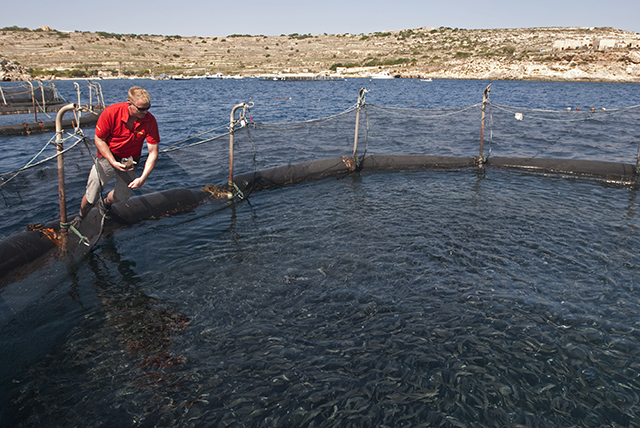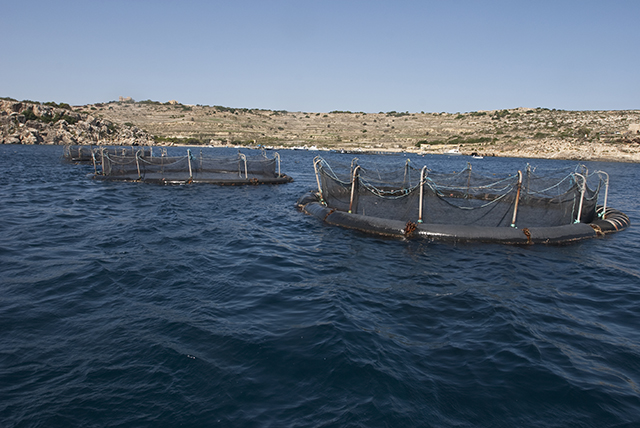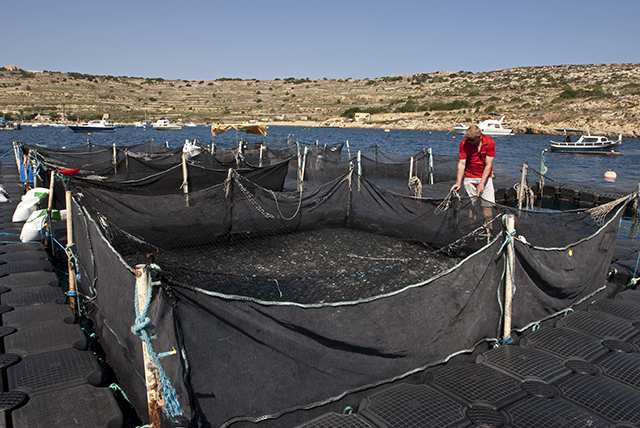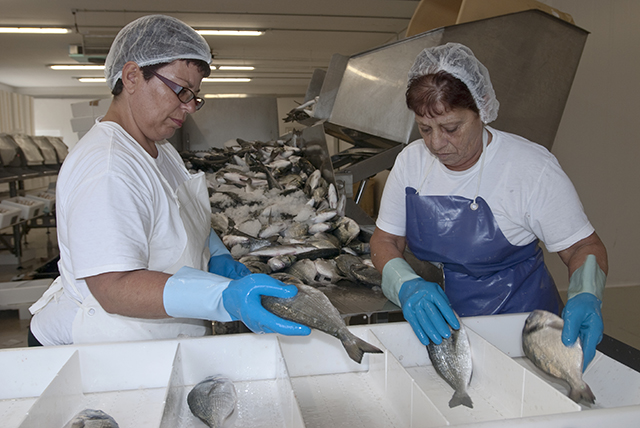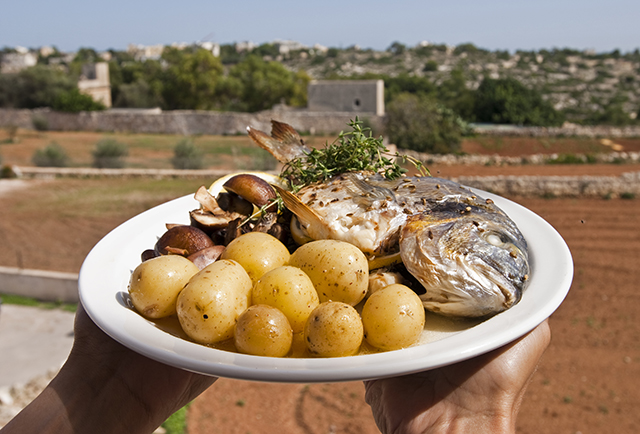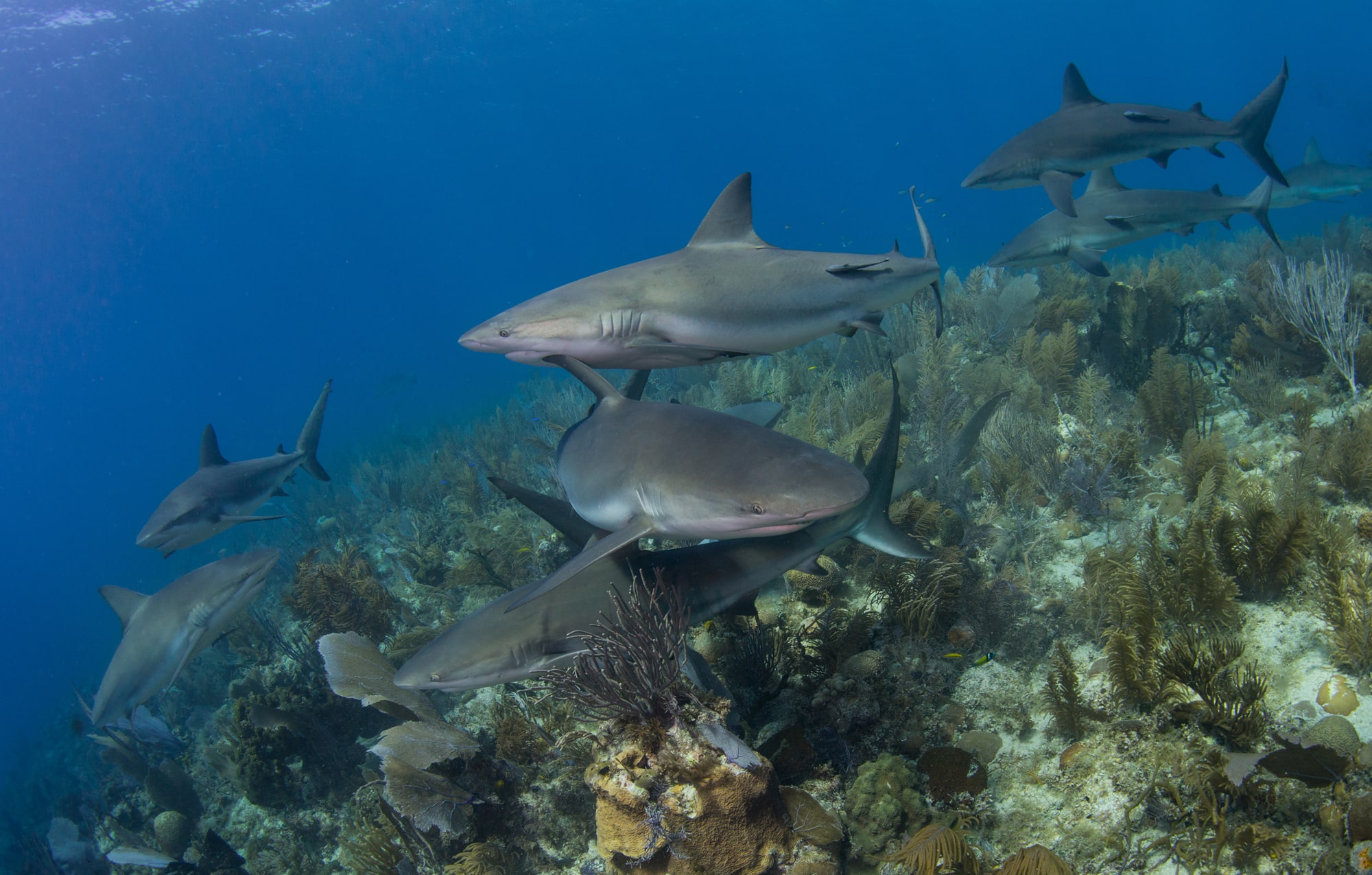Marine Life & Conservation
Aqua Farming: Fish For Thought
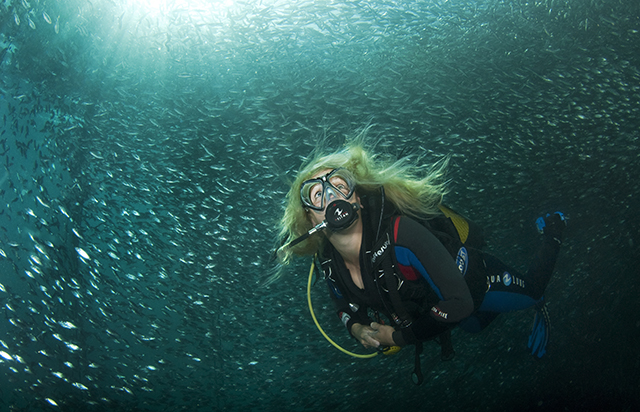
I would love to turn back the clocks and see the underwater world through Jacques Cousteau’s eyes. What an enviable experience – sailing the oceans, exploring pristine reefs thriving with marine life. But alas this is 2015, and as a globe-trotting scuba diver-come-photographer I am acutely aware of the problems facing our planet. Fish provide us with a vital food source but natural stocks are dwindling fast, in some cases so fast that a number of species including tuna are already on the IUCN critically endangered list. I can understand this is a complex situation, especially when there are mouths to feed and livelihoods at stake. Aqua farming may well be a viable solution.
In the quest to learn more I met up with Jes Brinch-Iverson, marine biologist and production manager for Pisciculture Marine De Malte (P2M) Limited. Jes, who has been associated with the company for the past 20 years, agreed to talk to me about the whole ‘farming’ process from its fingerling beginnings right through to serving up on a plate. The Maltese climate (water temp between 14-28 degrees) is ideal for cultivating sea bass (Dicentrarchus labrax), gilt-head sea bream (Sparus aurata) and meagre (Argyrosomus regius). Jes said they are also considering farming amberjacks (Seriola dumerili) sometime in the future.
In all P2M have 19 storage pens at St Pauls Bay and another 5 at Mellieha Bay. Jes said it’s difficult to get permits, especially for the inshore sites. Although the demand for fish farming is increasing there are strict regulations in place dictating depth limitations, environmental issues and proximity to tourism. P2M doesn’t receive any financial help from the Maltese government. Jes said “we do get some European funding for research into new products and improving quality”.
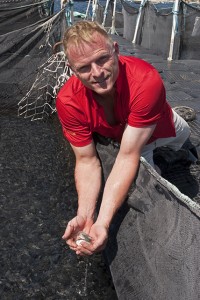 We hopped aboard one of P2M’s work boats and sped across to a cluster of small rectangular shaped pens located just a few hundred metres from the coastline. Jes wanted to show me a new batch of sea bream that had just arrived. The fingerlings or juveniles are supplied by companies from Spain, Italy and France. They are transported in trucks or put on cargo ships in large tanks. Oxygen is pumped into the water and the temperature reduced. This slows down the metabolism of the fish. A standard shipment is around 150,000 fingerlings. During the course of the journey there is about a 1% mortality rate.
We hopped aboard one of P2M’s work boats and sped across to a cluster of small rectangular shaped pens located just a few hundred metres from the coastline. Jes wanted to show me a new batch of sea bream that had just arrived. The fingerlings or juveniles are supplied by companies from Spain, Italy and France. They are transported in trucks or put on cargo ships in large tanks. Oxygen is pumped into the water and the temperature reduced. This slows down the metabolism of the fish. A standard shipment is around 150,000 fingerlings. During the course of the journey there is about a 1% mortality rate.
Jes scooped up a handful of the silvery sea bream fingerlings. He said “only the best quality fish are selected”. The fingerlings are around 100 days old when they arrive at the farm. Each little fish was roughly the size of my little finger and weighed approx 2g. Growth is related to feed and water temperature. Normally the fish are kept inside the holding pens for around 12 – 16 months before harvesting.
The floating pens basically comprise of a large doughnut shaped rubber float with an encompassing net like structure attached below. I watched Jes feeding the hungry hoard. The water surface was literally boiling with activity. The fish are fed twice a day. The fish meal is a mixture of soya, fish oil and vegetable. Proportionately it’s around 50 percent soya. The difference in taste from farmed and naturally wild fish is not significant and the texture is still the same. Jes said “we use high quality feed”. They regularly monitor the health of the fish. Jes said “problems with diseases are very rare. We don’t use any chemicals in the process”. There is also a team of scuba divers on hand to check the nets for holes and do routine maintenance/cleaning tasks. After a particularly bad storm in March 2012 they lost around 8% of the total stock from damaged pens. The local residents had an absolute field day catching all the fish and taking them home for a free bumper supper.
I wanted to try and get some underwater pictures of the farmed fish, so Jes suggested jumping into a 400 cu metre pen which was about 5 metres in diameter and 5 metres deep. The pen was populated with around 100,000 sea bass of sizes between 30 – 40g, which were roughly the length of my hand. Just to make my pictures a little more interesting I invited along local scuba diver Trudy Kerr. This would also add some perspective of size and scale. Both Trudy and Jes were regulars at Maltaqua dive centre based at St Pauls Bay.
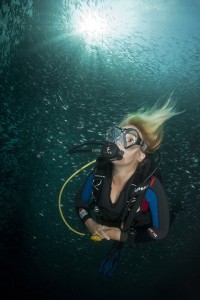
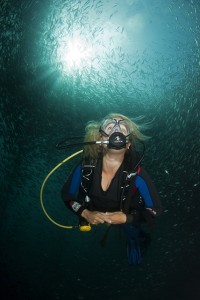 Just before entering the water we encountered a disastrous show stopper of a problem. Trudy’s semi-dry suit zip had stuck open. Unfortunately the zip in question was located right by Trudy’s cleavage. Trudy asked if we should abort the dive. I looked at Jes and he looked back at me. In about 3 micro seconds we made a joint executive decision to soldier on despite this major setback. So the sea bass ended up getting slightly more of an eyeful than expected. No wonder why they were flying around the pen in a complete frenzy! I really enjoyed being inside the pen surrounded by so many fish. I spent more than 45 minutes taking pictures of the swirling shoal. If I have one complaint to make, the fish could have been a tad bigger. Otherwise the visibility wasn’t too bad, there wasn’t too much detritus (fish poo) floating about and the lighting was okay. Trudy’s zip had by that point miraculously repaired itself.
Just before entering the water we encountered a disastrous show stopper of a problem. Trudy’s semi-dry suit zip had stuck open. Unfortunately the zip in question was located right by Trudy’s cleavage. Trudy asked if we should abort the dive. I looked at Jes and he looked back at me. In about 3 micro seconds we made a joint executive decision to soldier on despite this major setback. So the sea bass ended up getting slightly more of an eyeful than expected. No wonder why they were flying around the pen in a complete frenzy! I really enjoyed being inside the pen surrounded by so many fish. I spent more than 45 minutes taking pictures of the swirling shoal. If I have one complaint to make, the fish could have been a tad bigger. Otherwise the visibility wasn’t too bad, there wasn’t too much detritus (fish poo) floating about and the lighting was okay. Trudy’s zip had by that point miraculously repaired itself.
I had noticed quite a few local fishermen dangling rods close to the holding pens but couldn’t quite fathom out why, unless of course some of the fish managed to escaped from time to time. I heard Trudy shouting through her regulator and pointing outside the pen. I followed her line of sight and saw a giant trevally shaped predatory fish circling us. It was absolutely massive (1.5 metres long) and made me wonder what else might be out there beyond the mesh. Now that really was a scary thought… especially with the tuna pens being so close…
When we were safely back on board Jes took us over to one of the offshore pens full of larger sea bass. Jes said the 3,000 cu metre enclosure was around 15 metres in diameter and 12 metres deep. But the visibility was not so good inside this pen and the skittish fish were not so easy to photograph. We found 100’s of sea hares lying on the bottom which kept Trudy occupied for ages. Sea hares are herbivores so there must have been some kind of algae or plant life growing inside the pens that they liked to eat; or was it the fish poo? After 25 frustrating backscatter filled minutes I gave up taking photographs. I noticed there was a handful of dead fish bobbing about on the surface. Jes said this was the normal fall out rate. I’m not sure what had killed them and should have asked the question.
Before returning to the jetty Jes showed me the special harvesting boat. It works just like a giant vacuum cleaner sucking up the fish and passing them through a fast freeze unit. The cold shock instantly kills the fish. Any delay will affect the quality. They are then transferred to the nearby packing and processing plant. P2M had recently moved to new purpose built premises which also included a storage facility and office space. The company is privately owned and presently employs 51 people. Jes took me on a tour around the new plant. They were in the middle of processing a batch of sea bream. I watched the bream being unloaded and sorted onto a conveyor belt. The fish are rinsed, packaged up into boxes (at around 7kg a box) and transferred to ice trucks ready for delivery. I was impressed. The entire process took no more than 45 minutes.
The fish are not gutted and filleted, they are left whole. Jes said that the ideal ‘portion’ size for consumers weighs between 350 and 450g. On the open market prices are around 4 to 5 euro per kg. There are presently 6 fish farms in Malta exporting around 2,000 tons of cultivated fish each year of which a large percentage is shipped to supermarket chains in Italy. Delivery times from the holding pens to the local Maltese restaurants can be just a few hours. International deliveries usually take up to 24 hours. Jes said the fish have a 12-day shelf life.
I had learnt that Aqua farming doesn’t come cheap and there are many costs to consider. P2M do make a profit but fish are deemed an expensive commodity and demand is not so high. Jes said “the supermarkets dictate the prices and make most of the money”. Malta is planning to expand the aqua farming industry over the coming years. In my mind this is great news. More farmed fish means less fish taken from the sea which gives me a better chance of getting some half decent photographs.
Just to round off my day Jes handed me a sea bream sample for taste testing. I had never eaten sea bream before so was really looking forward to checking it out. The fish didn’t take very long to prepare or cook, especially as I wasn’t cooking it! I thought the roasted sea bream had quite a delicate texture and most of the flavour seemed to come from the herbs and the lemon. There were a few bones to contend with, but what did I expect – this was a fish! I would definitely eat it again and a bottle of chilled Gavi is the perfect accompaniment.
What are your views on aqua farming? Let us know in the comments section below.
Marine Life & Conservation
Double Bubble for Basking Sharks

 The Shark Trust is excited to announce that, for two more days only, all donations, large or small, will be doubled in the Big Give Green Match Fund!
The Shark Trust is excited to announce that, for two more days only, all donations, large or small, will be doubled in the Big Give Green Match Fund!
Donate to Basking in Nature: Sighting Giants
The Shark Trust is hoping to raise £10k which will be doubled to £20k. This will go towards Basking in Nature: Sighting Giants. And they need YOUR help to reach they’re goal.
The Shark Trust’s citizen science project is to monitor and assess basking sharks through sightings; encouraging data collection, community engagement, and promoting nature accessibility. This initiative aims to enhance health and wellbeing by fostering a deeper connection with British Sharks.
Campaign Aims
- Increase citizen science reporting of Basking Sharks and other shark sightings to help inform shark and ray conservation.
- Provide educational talks about the diverse range of sharks and rays in British waters and accessible identification guides!
- Create engaging and fun information panels on how to ID the amazing sharks and rays we have on our doorstep! These can be used on coastal paths around the Southwest. With activities and information on how you can make a difference for sharks and rays!
- Promote mental wellbeing through increasing time in nature and discovering the wonders beneath the waves!
Donate, and double your impact. Click Here
Marine Life & Conservation
Leading UK-based shark conservation charity, the Shark Trust, is delighted to announce tour operator Diverse Travel as a Corporate Patron
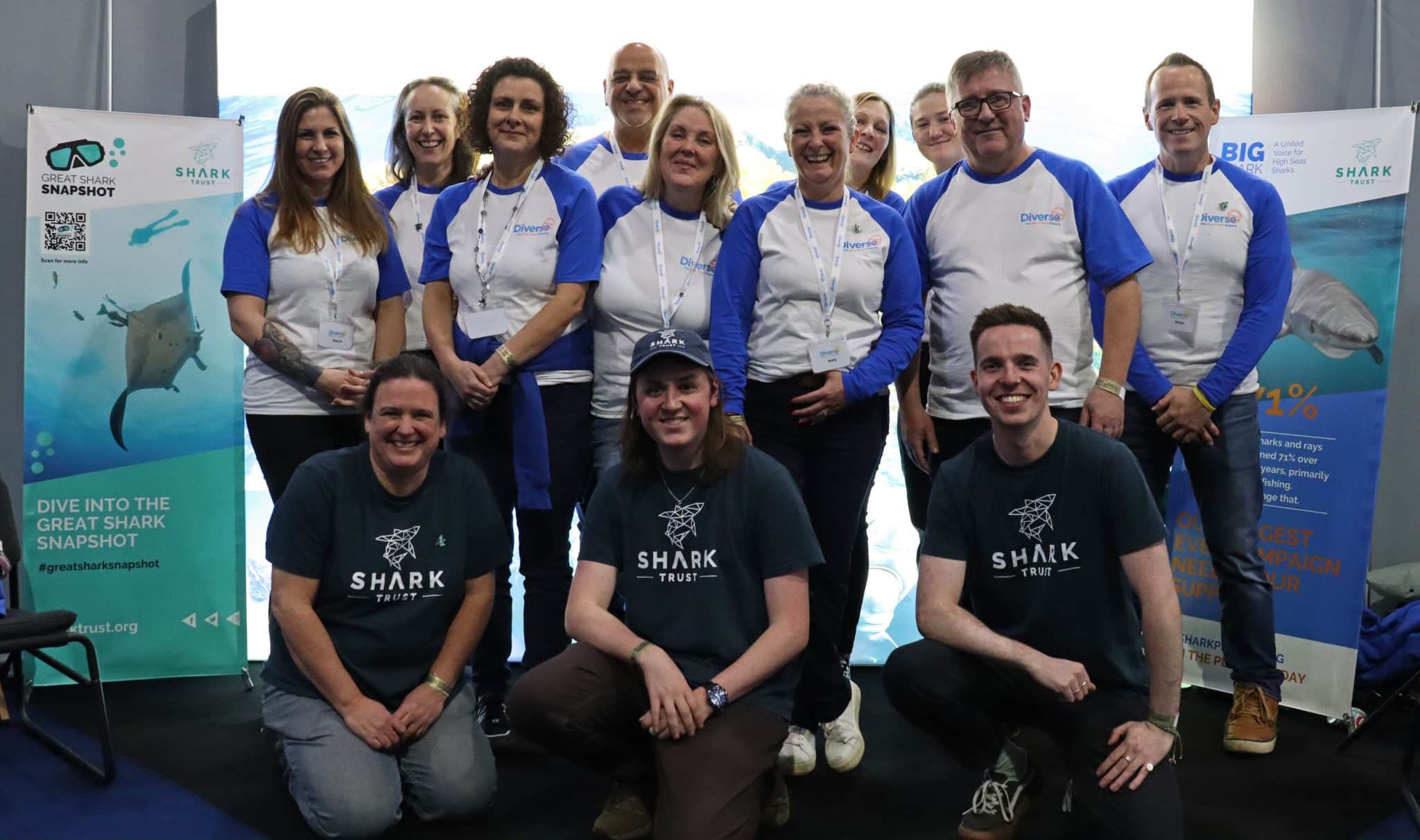
 Corporate Patrons provide a valuable boost to the work of The Shark Trust. The Trust team works globally to safeguard the future of sharks, and their close cousins, the skates and rays, engaging with a global network of scientists, policymakers, conservation professionals, businesses and supporters to further shark conservation.
Corporate Patrons provide a valuable boost to the work of The Shark Trust. The Trust team works globally to safeguard the future of sharks, and their close cousins, the skates and rays, engaging with a global network of scientists, policymakers, conservation professionals, businesses and supporters to further shark conservation.
Specialist tour operator Diverse Travel has operated since 2014 and is committed to offering its guests high quality, sustainable scuba diving holidays worldwide. Working together with the Shark Trust will enable both organisations to widen engagement and encourage divers and snorkellers to actively get involved in shark conservation.
“Sharks are truly at the heart of every diver and at Diverse Travel, we absolutely share that passion. There is nothing like seeing a shark in the wild – it’s a moment that stays with you forever!” says Holly Bredin, Sales & Marketing Manager, Diverse Travel.
“We’re delighted to celebrate our 10th year of business by becoming a Corporate Patron of the Shark Trust. This is an exciting partnership for Diverse and our guests. We will be donating on behalf of every person who books a holiday with us to contribute towards their vital shark conservation initiatives around the world. We will also be working together with the Trust to inspire divers, snorkellers and other travellers to take an active role – at home and abroad – in citizen science projects and other activities.”
Paul Cox, CEO of The Shark Trust, said:
“It’s an exciting partnership and we’re thrilled to be working with Diverse Travel to enable more divers and travellers to get involved with sharks and shark conservation. Sharks face considerable conservation challenges but, through collaboration and collective action, we can secure a brighter future for sharks and their ocean home. This new partnership takes us one more valuable step towards that goal.”
For more information about the Shark Trust visit their website here.
For more about Diverse Travel click here.
-

 News3 months ago
News3 months agoHone your underwater photography skills with Alphamarine Photography at Red Sea Diving Safari in March
-

 News3 months ago
News3 months agoCapturing Critters in Lembeh Underwater Photography Workshop 2024: Event Roundup
-

 Marine Life & Conservation Blogs3 months ago
Marine Life & Conservation Blogs3 months agoCreature Feature: Swell Sharks
-

 Blogs2 months ago
Blogs2 months agoMurex Resorts: Passport to Paradise!
-

 Blogs2 months ago
Blogs2 months agoDiver Discovering Whale Skeletons Beneath Ice Judged World’s Best Underwater Photograph
-

 Gear Reviews2 weeks ago
Gear Reviews2 weeks agoGEAR REVIEW – Revolutionising Diving Comfort: The Sharkskin T2 Chillproof Suit
-

 Marine Life & Conservation2 months ago
Marine Life & Conservation2 months agoSave the Manatee Club launches brand new webcams at Silver Springs State Park, Florida
-

 Gear Reviews3 months ago
Gear Reviews3 months agoGear Review: Oceanic+ Dive Housing for iPhone


